Contents
Anise lofant – an unpretentious, but decorative honey plant and a medicinal plant rich in essential oils, is becoming popular in the gardens of many summer residents. The cultivation is simple, fresh and dried raw materials are used for health maintenance and culinary purposes.

Description of grass lofant anise
The lofant bush, or fennel multi-grate, rises from 45-60 cm to 1-1,5 m, consists of 4-10 tetrahedral green stems with toothed heart-lanceolate leaves of bright green color, arranged oppositely. The stems are branching. Leaf blade on a long petiole measuring 8-10 cm x 3-4 cm. Peduncles are formed on the tops of stems up to 7-12 pieces. Inflorescences spike-shaped, 12-20 cm long, 3-4 cm in diameter, consist of two-lipped flowers. The color of the corollas of the lofant varies depending on the variety and type: from white to lilac and purple. The buds appear by the end of May, the bush can bloom continuously for 4 months if the stems are cut. In this case, the plant forms new flower stalks in a larger number.
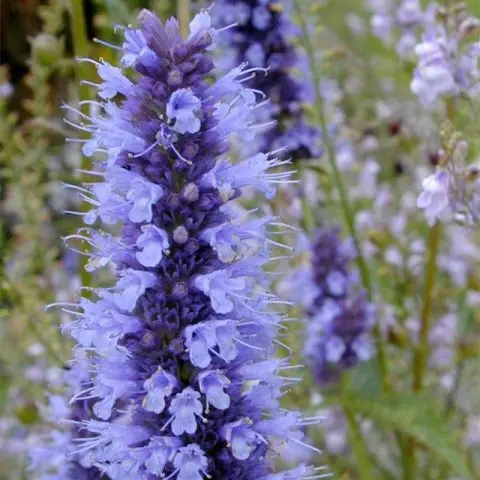
Varieties of anise lofant
Spectacular ornamental shrub, generous anise lofant honey plant is distributed in gardens in the form of several varieties from well-known domestic companies: SeDeK, Gavrish, Gardens of Our Country and others. The differences between lofant specimens are in the shades of flowers and the range of aromas, more often aniseed. Differences in smells are not significant, but they have specific shades.
Lofant anise Snowball
Sun-loving perennial variety, stems in 4 faces, grow up to 60-70 cm. Spike-shaped inflorescences, 8-16 cm long, consisting of small flowers with white petals. A plant with a pleasant anise smell, the leaves give the dishes an original taste with sweetish notes. In the conditions of the middle lane, it is grown as an annual.

Witch
The variety does not tolerate severe frosts, so the seeds are sown every spring. As a perennial plant grown in the southern regions. Stems 0,5-0,7 cm high, erect, form a lush bush from one fibrous root. Spike inflorescences are blue-violet, formed from small flowers with long stamens.
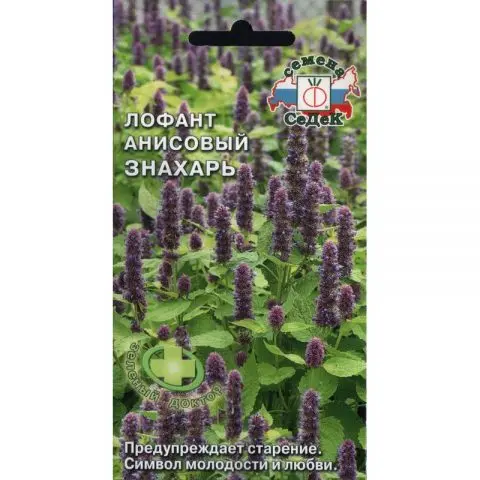
Summer resident
This lofant has inflorescences of a white shade, 10-20 cm long. Placed on strong stems that rise straight from the root, 50 to 80 cm high. In the regions of the middle climatic zone of Our Country, it is grown as an annual. In regions where winters are mild, it grows in one place for 5-6 years. Then, to update the bush is divided and transplanted.
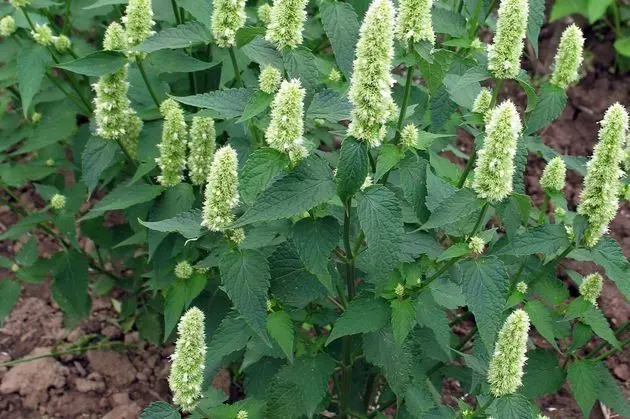
premier
Blue-violet small flowers of the variety are collected in large spikelets 16-22 cm long. The stems are strong, 4-sided, form an upright bush 80-150 cm. The odorous medicinal and culinary raw materials are cut off after 40-60 days of plant development. Young leaves with an anise flavor are used in salads, to flavor tea or compote.
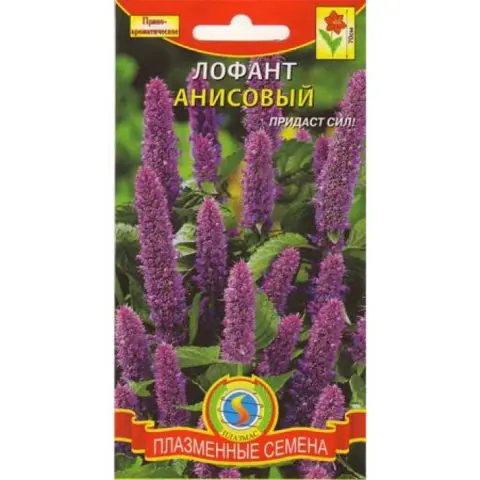
Frant
Strong stems of the variety from a fibrous root grow straight up, reach up to 90-110 cm. The plant branches to the top. The stems bear many large inflorescences, 8-15 cm long, in the form of an ear with small lilac flowers. As a medicinal raw material, the stems are cut when the inflorescences bloom. Young leaves are used for cooking.
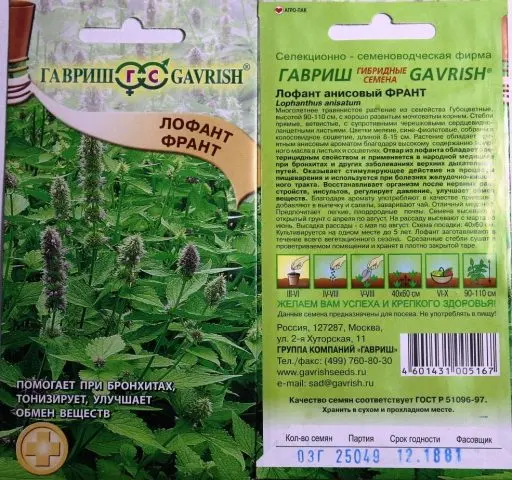
Planting and caring for anise lofant
An unpretentious plant reproduces by dividing the bush or by seeds. The second method is more acceptable for regions in which the temperature drops from -20 ° C in winter. Lofant seeds are sown in the ground at the end of April or in May. Grow seedlings since March. Standard care: moderate watering and a bright room.
Growing anise lofant will be successful on fertile land with neutral acidity. The plant blooms poorly, and the stems branch poorly on poor sandy soils, as well as in areas where groundwater is highly suitable, and on acidic soils. The culture is drought-resistant, loves sunny places. Seeds are sown to a depth of 3 cm. Seedlings appear after 7-9 days. When thinning, sprouts are left after 25-30 cm, between rows there is an interval of 60-70 cm. The earth is periodically loosened, especially after watering. Weeds are removed, and as they grow, the strong, densely leafy stems of the lofant oppress uninvited neighbors.
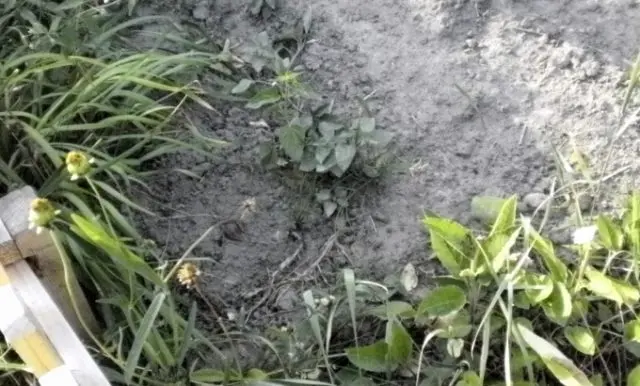
Caring for a lofant is simple:
- watering plantings of a medicinal plant once a week;
- having cut off the odorous anise stems, the plant is fed with mullein infusion, diluted in a ratio of 1:5;
- winter-hardy perennial varieties are divided for propagation in spring or autumn;
- for the winter, frost-resistant perennials are pruned, leaving stems 8-12 cm high above the ground;
- later covered with leaves.
Sufficient moisture contributes to the violent development of the lofant bush, the branching of the stems and the abundant formation of peduncles. Frequent cutting of flowering spikelets provokes a new wave of flower stalks formation. Plants have fibrous powerful roots with a central stem, delenki take root well. In one place, the culture can successfully develop up to 6-7 years, then a transplant is necessary. Diseases and pests do not threaten the lofant.
The chemical composition of the plant
The grass of the culture consists of 15% essential oil, which explains the strong effect of the medicinal plant anise lofant. The oil contains 80% of the chemical methylchavicol, which characterizes the tarragon or tarragon plant known in cooking. The components of the oil change, depending on them, the amount of anise smell also varies.
Acids:
- ascorbic;
- coffee;
- malic
- lemon.
There are tannins – 8,5%, vitamins C, B1 and B2.
Lots of minerals
- more than 10000 mcg / g of calcium and potassium;
- above 2000 mcg / g of magnesium and sodium;
- iron 750 mcg/g;
- as well as boron, iodine, copper, manganese, selenium, chromium, zinc.
Useful properties of anise lofant
The components of essential oil and other components of raw materials from anise lofant have the following effects:
- bactericidal;
- tonic;
- diuretic;
- antihelminthic;
- antispasmodic.
The herb is known for producing antioxidant, immunostimulating, fungicidal effects. Supports blood vessels in atherosclerosis, hypertension, cleanses the body of toxins, normalizes metabolism. There are references that the active substances of anise lofant promote the growth of cancer cells. Traditional healers who have a plant in their medical arsenal tend to the opposite opinion.
Anise lofant is useful not only for humans. Mistresses give chopped grass to chickens, which, with its constant use, increase egg production. Goats also increase their milk yield if they are fed a few stalks of anise grass a day.
Rules of raw material procurement
In cooking, tender young leaves of anise lofant aged 30-40 days are used for various dishes – salads, fish, meat. Flowers, seeds, as well as leaves with a bright aroma of anise, are used in compotes, dough, and preservation.
The most complete accumulation of components with medicinal properties is observed during the creation of buds and flowering. Medicinal raw materials of anise lofant are harvested during this period:
- cut stems with leaves and peduncles;
- dry in the shade, with a thin layer;
- drying is also carried out in ventilated rooms;
- dried grass is stored in cloth bags, thick paper envelopes, glass containers so that the anise flavor does not disappear.

Indications for use
As a medicinal plant, anise lofant is not used in official medicine; it is not included in the list of the State Register as a culture recommended for cultivation. But domestic scientists conducted a number of studies that showed the feasibility of using herbal medicinal raw materials for use in diseases:
- upper respiratory tract;
- genitourinary system;
- gastrointestinal tract.
And also for the treatment of fungal infections and providing a general strengthening effect on the body.
Traditional medicine advises the use of medicinal raw materials with a strong anise flavor for:
- treatment of bronchitis and bronchial asthma;
- maintaining a normal pancreas;
- stimulation of the cardiovascular system after a heart attack or stroke;
- normalization of the kidneys and urinary tract.
A decoction of medicinal raw materials from a lofant relieves blood vessels of cholesterol plaques, helps to normalize blood pressure during incipient hypertension, and has a calming effect on minor tachycardia and angina pectoris. Tea gently relieves headaches, including those due to migraines. The same sparing analgesic effect has a decoction of herbs in case of gastritis, stomach ulcers, enteritis. Some gardeners are especially attracted to the cultivation of a lofant by the information that the regular addition of a few fresh leaves to the diet increases male potency. Antioxidant and immune-stimulating substances of anise lofant inhibit the aging process and promote tissue renewal at the cellular level. Compresses with a decoction of medicinal raw materials and baths relieve foci of inflammation on the skin, alleviate the condition of purulent wounds.
If there are no contraindications, it is useful to use the medicinal herb of anise lofant for culinary or medicinal purposes for residents of megacities and other cities with problematic ecology. Active substances easily cope with the removal of unwanted compounds from the body and promote healing.
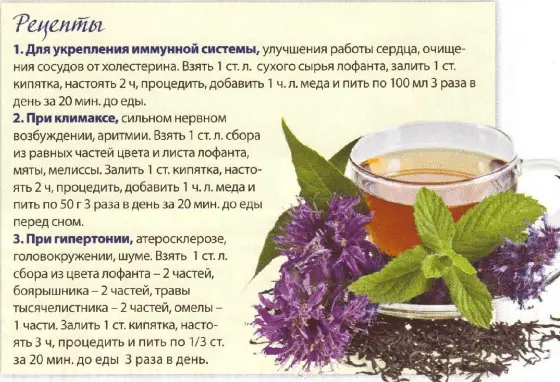
Methods of Use
More often, fresh and dried raw materials of anise lofant are used in the form of decoctions or tea, sometimes tinctures or ointments are made.
- tea is prepared by brewing 1 tbsp. l. raw materials 200 ml of boiling water – consumed three times a day;
- the infusion is brewed in a thermos: 2 tablespoons of grass per 400 ml, which is consumed 100 ml three times before meals;
- the broth is prepared in a water bath, pouring 200 ml of boiling water 2 tbsp. l. stems, leaves, lofant flowers, boil for 6-9 minutes, and use 50 ml 3-4 times a day;
- alcohol tinctures are made from 50 g of dried raw materials or 200 g of fresh and 500 ml of vodka, kept for up to a month, then taken 21-26 drops three times a day with water for 21-28 days with the same break;
- a decoction for problem skin is made from 200 g of grass, which is boiled for 10 minutes in 2 liters of water and poured into a bath;
- a concentrated decoction for purulent wounds, boils, rinses with stomatitis, sore throat, rinsing the head with dandruff is prepared from 3-4 tbsp. l. herbs in a glass of water;
- extracts based on various vegetable oils, which are poured with crushed grass with an anise smell, are used in cosmetology.
Противопоказания
Before use, carefully study the medicinal properties and contraindications of anise lofant. Doctors forbid cancer patients to use any form of the plant. Carefully, you should start drinking a decoction or making lotions for people who have already been diagnosed with an allergy. Lofant is also undesirable for:
- pregnant, lactating mothers;
- children under 12 years of age;
- hypotension to reduce pressure;
- suffering from thrombophlebitis, convulsions, epilepsy.
Before using anise lofant, it is better to consult a doctor.
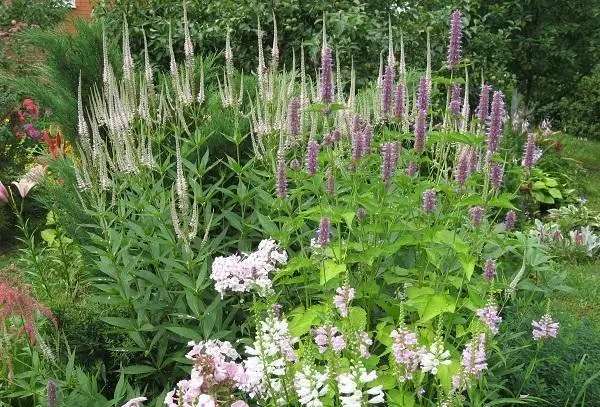
Conclusion
The anise lofant will decorate the site, a pleasant find for the bees, its leaves will bring a unique sweetish aroma to the tea. Before using decoctions and other dosage forms from a plant, you need to carefully study its properties and contraindications.









